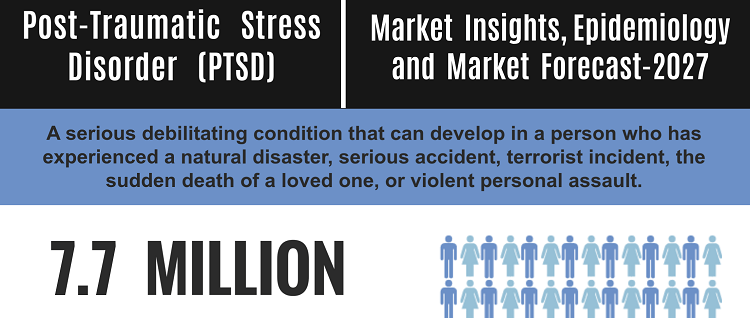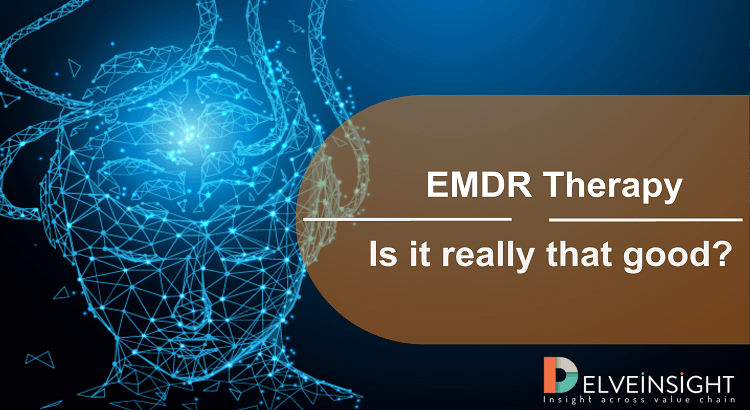Which Pharma Companies are going to Transform the Post Traumatic Stress Disorder Treatment Market?
May 06, 2022
Table of Contents
Post Traumatic Stress Disorder (PTSD) is a ” complex physical, cognitive, emotional, and behavioral consequences of psychological trauma.” It is characterized by intrusive thoughts, nightmares, flashbacks to past traumatic events, avoidance of traumatic reminders, hypervigilance, and sleep disturbance, all of which contribute to significant social, occupational, and interpersonal dysfunction. Post Traumatic Stress Disorder causes include feelings like intense fear, helplessness, and horror.
Post Traumatic Stress Disorder symptoms can occur as soon as a month after a stressful experience, but they can also appear years later. These Post Traumatic Stress Disorder symptoms generate substantial issues in social and work circumstances, as well as in relationships. They can also impair one’s capacity to carry out routine everyday activities. Post Traumatic Stress Disorder symptoms are divided into four types: intrusive recollections, avoidance, unfavorable changes in thinking and mood, and changes in physical and emotional reactions. Post Traumatic Stress Disorder symptoms may vary from person to person and over time.
Downloads
Article in PDF
The doctor will most likely perform a physical exam to rule out any medical issues that may be causing the symptoms – a psychological evaluation that includes a discussion of the signs and symptoms, as well as the event or events that precipitated them, and will employ the criteria from the Diagnostic and Statistical Manual of Mental Disorders (DSM-5) for the diagnosis of PTSD.
Post Traumatic Stress Disorder Epidemiological Insights
Post Traumatic Stress Disorder affects approximately 3.5% of adults in the US every year, and an estimated 1 in 11 people will be diagnosed with PTSD in their lifetime. Moreover, women are twice as likely as men to have Post Traumatic Stress Disorder. As per DelveInsight’s Post Traumatic Stress Disorder Epidemiology Forecast Report, the PTSD prevalence in the 7MM in 2021 was more than 13 million, out of which the diagnosed prevalent cases were more than 5 million. DelveInsight estimates that the PTSD prevalence in the 7MM is further expected to increase by 2032. Moreover, the highest Post Traumatic Stress Disorder prevalence was observed in the US.
Current Post Traumatic Stress Disorder Treatment Landscape
The multidimensional strategy is used in the treatments for PTSD patients. The current Post Traumatic Stress Disorder treatment options include patient education, social support, and anxiety control through psychotherapy and psychopharmacological intervention. Patient education and social support are critical early measures for engaging the patient and mitigating the impact of the traumatic experience. Local and national support groups can assist in de-stigmatize mental health diagnoses and emphasize that Post Traumatic Stress Disorder symptoms are more than just a reaction to stress and require Post Traumatic Stress Disorder treatment. Family and friend support fosters understanding and acceptance, which may lessen survivor guilt. Psychotherapy and counseling, therapies, or a mix of these two are commonly used in the treatment for PTSD patients.
Sertraline is also used in PTSD treatment. Sertraline (Zoloft) increases serotonergic activity in the central nervous system by blocking neuronal reuptake of serotonin (5-HT). It is an antidepressant that belongs to a class of drugs known as selective serotonin reuptake inhibitors (SSRIs). Sertraline affects brain chemicals that may be out of balance in people suffering from depression, panic attacks, anxiety, or obsessive-compulsive disorder.
Furthermore, the mechanism of action of Paxil (Paroxetine) in PTSD treatment is unknown, however, it is thought to be related to the potentiation of serotonergic activity in the central nervous system caused by inhibition of neuronal reuptake of serotonin (5-hydroxy-tryptamine, 5-HT). Both these drugs are not much effective in the treatment of Post Traumatic Stress Disorder. The lack of therapies in the market enables physicians to rely on and prescribe off-label therapies having indeterminable efficacy.
Post Traumatic Stress Disorder Market Insights
DelveInsight estimates a surge in the Post Traumatic Stress Disorder market size owing to the increase in the prevalence and rise in initiatives to create public awareness and knowledge of the disease. The Post Traumatic Stress Disorder market size in the 7MM in 2021 was USD 1,740.2 million, which is further expected to increase by 2032 growing with a significant CAGR. The emergence of late-stage pipeline therapies is one of the key factors driving the growth of the PTSD market, Moreover, the dynamics of the PTSD treatment market are anticipated to change in the coming years owing to several factors. One of the major reasons which are driving the Post Traumatic Stress Disorder market is the introduction of novel drugs and classes of new therapeutic drugs for Post Traumatic Stress Disorder treatment in the market will give patients hope as PTSD treatment options and may have a significant positive impact on the Post Traumatic Stress Disorder market. In addition, a less competitive scenario will create an opportunity for the new players with novel PTSD therapy to enter into the Post Traumatic Stress Disorder market.
Furthermore, with a few promising therapies in the Post Traumatic Stress Disorder pipeline, the Post Traumatic Stress Disorder treatment market size is projected to grow. Among the emerging therapies, the most promising ones include JZP150 (Jazz Pharmaceuticals), NYX-783 (Aptinyx), BNC210 (Bionomics Limited), and others.

Post Traumatic Stress Disorder Emerging Therapies
Several pharmaceutical Post Traumatic Stress Disorder companies such as Jazz Pharmaceuticals, Aptinyx, Otsuka Pharmaceutical Development & Commercialization, Inc., Bionomics Limited, Boehringer Ingelheim, GlaxoSmithKline, AstraZeneca, Remedy, H. Lundbeck A/S, Alto Neuroscience, Yale University, Sage Therapeutics, Pfizer, Tonix Pharmaceuticals, Inc., Nobilis Therapeutics, and others are among the companies active in the development of Post Traumatic Stress Disorder therapies. As a result, the anticipated launch of Post Traumatic Stress Disorder treatment drugs may gain a competitive advantage in the Post Traumatic Stress Disorder treatment market. Among the promising Post Traumatic Stress Disorder drugs in various stages of development, some are:
JZP150 (Jazz Pharmaceuticals) is an orally administered, highly selective inhibitor of the enzyme fatty acid amide hydrolase (FAAH) developed by Jazz Pharmaceuticals to treat the underlying causes of Post Traumatic Stress Disorder (impairment of fear extinction and consolidation) as well as the associated symptoms in patients (anxiety, insomnia, and nightmares).
NYX-783 (Aptinyx) is a novel, oral, small molecule that affects the N-methyl-D-aspartate receptor (NMDAR) that Aptinyx is developing for Post Traumatic Stress Disorder. Preclinical studies with NYX-783 revealed particularly promising results in psychiatric models, fear extinction models, and substance abuse models. Ample central nervous system exposure was seen in Phase I clinical investigation of NYX-783, and the product candidate displayed a positive adverse event and tolerability profile, with no significant adverse effects across a wide dose range.
The combination of Brexpiprazole and Zoloft is being evaluated by the Otsuka Pharmaceutical Development for the Post Traumatic Stress Disorder treatment. Brexpiprazole is a novel D2 dopamine and serotonin 1A partial agonist known as a serotonin-dopamine activity modulator (SDAM), as well as a powerful antagonist of serotonin 2A receptors, nor-adrenergic alpha 1B, and 2C receptors. Whereas Zoloft is an antidepressant that belongs to a class of medications known as selective serotonin reuptake inhibitors (SSRIs). It changes brain chemicals that may be out of balance in persons suffering from depression, panic attacks, anxiety, or obsessive-compulsive symptoms.
BNC210 is a patented chemical in development by Bionomics for the treatment of Social Anxiety Disorder (SAD), Post-Traumatic Stress Disorder treatment, and anxiety disorders treatment. It possesses a new mechanism of action as a negative allosteric modulator of the alpha 7 nicotinic acetylcholine receptor (7 nAChR), and thorough non-clinical and clinical research has revealed various features that may be effective in Post Traumatic Stress Disorder treatment along with Social Anxiety Disorder, and anxiety disorders treatment.
Expected Roadblocks
The Post Traumatic Stress Disorder market size is increasing, however, certain factors are limiting the growth of the Post Traumatic Stress Disorder treatment market. The main drawback of PTSD is that it is associated with high rates of comorbidities, psychiatric and medical diseases, as well as alcohol and drug abuse, resulting in poor QOL and poor physical health, thus impeding the growth of the Post Traumatic Stress Disorder treatment market. In addition, the heterogeneity of the symptoms and delayed onset of PTSD are acting as a barrier to the growth of the Post Traumatic Stress Disorder treatment market. Moreover, with the expiration of patent protection for many pharmaceuticals and rising healthcare costs, the entry of generics occurs, posing a significant challenge to the Post Traumatic Stress Disorder treatment market.

FAQs
Post Traumatic Stress Disorder (PTSD) has been defined as "the complex physical, cognitive, emotional, and behavioral consequences of psychological trauma." It is characterized by intrusive thoughts, nightmares, flashbacks to past traumatic events, avoidance of traumatic reminders, hypervigilance, and sleep disturbance, all of which contribute to significant social, occupational, and interpersonal dysfunction.
Post Traumatic Stress Disorder symptoms can occur as soon as a month after a stressful experience, but they can also appear years later. These Post Traumatic Stress Disorder symptoms generate substantial issues in social and work circumstances, as well as in relationships. They can also impair one's capacity to carry out routine everyday activities.
As per DelveInsight Post Traumatic Stress Disorder Epidemiology Forecast Report, the Post Traumatic Stress Disorder prevalence in the 7MM in 2021 was more than 13 million, out of which the diagnosed prevalent cases were more than 5 million. DelveInsight estimates that the PTSD prevalence in the 7MM is further expected to increase by 2032.
Several pharmaceutical companies such as Jazz Pharmaceuticals, Aptinyx, Otsuka Pharmaceutical Development & Commercialization, Inc., Bionomics Limited, Boehringer Ingelheim, GlaxoSmithKline, AstraZeneca, Remedy, H. Lundbeck A/S, Alto Neuroscience, Yale University, Sage Therapeutics, Pfizer, Tonix Pharmaceuticals, Inc., Nobilis Therapeutics, and others are among the companies active in the development of Post Traumatic Stress Disorder therapies.
The emerging therapies in the Post Traumatic Stress Disorder pipeline include JZP150, Aptinyx, Brexpiprazole and Zoloft combination, BNC210, and others.
The doctor will most likely perform a physical exam to rule out any medical issues that may be causing the symptoms – a psychological evaluation that includes a discussion of the signs and symptoms, as well as the event or events that precipitated them, and will employ the criteria from the Diagnostic and Statistical Manual of Mental Disorders (DSM-5) for the diagnosis of PTSD.
The multidimensional strategy is used in PTSD management. The current Post Traumatic Stress Disorder treatment options include patient education, social support, and anxiety control through psychotherapy and psychopharmacological intervention.
There are two PTSD medicine used for PTSD treatment. These PTSD medicine include Sertraline (Zoloft) and Paxil (Paroxetine).
Downloads
Article in PDF



